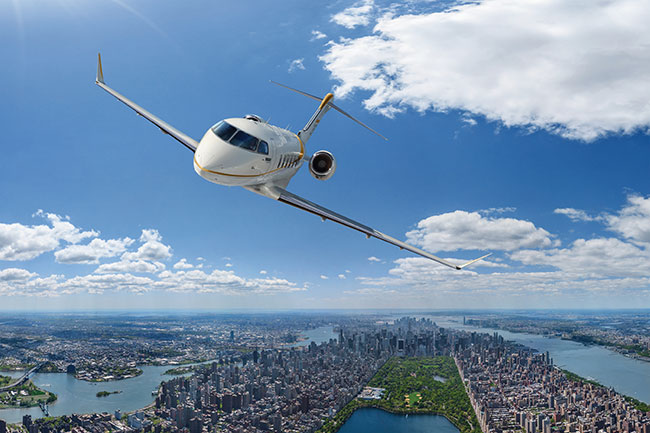
News
Aircraft manufacturers
Alternate Approach: Pay to stay
Downsized Bombardier needs a New Age challenger
November 10, 2020 By David Carr
 The Challenger 350 aircraft has been the best-selling super mid-size business jet for six consecutive years in GAMA’s annual sector report. (Photo: Bombardier)
The Challenger 350 aircraft has been the best-selling super mid-size business jet for six consecutive years in GAMA’s annual sector report. (Photo: Bombardier) Will the next Big Thing be enough to save Bombardier, and what could it be? Bombardier pioneered the regional jet revolution, built the game changing Airbus A220 and redefined ultra-long-range executive jet travel with the Global 7500.
The sale of the aerostructures division, including proprietary technology behind the ground-breaking A220 wing to Wichita-based Spirit AeroSystems closed on Halloween. A deal to sell the railway business to France’s Alstrom will be finalized in early 2021. A one-time global transportation giant is a step closer to a pure-play business jet manufacturer that must hold its own in a cyclical industry where competitors are part of larger, more diversified aerospace corporations with deeper pockets. In a cruel twist, Airbus is pitching the A220 against the 7500 for customers wanting an ultra-large cabin but not requiring the range of the Global.
Bombardier is the only end-to-end OEM with a presence in the entry-level, super mid-size and large-cabin, ultra long-range categories, anchored by the pace-setting 7500 and top-selling Challenger 350. But sales at Learjet, the lower end of the line have slowed even with October’s entry into service of the Learjet 75 Liberty, an updated Learjet 75 better positioned to compete with the Cessna CG3+ and Embraer Phenom 300E.
Bombardier is not behaving like a company eyeing the final exit. In addition to the 75 Liberty, it has trimmed costs, announced cabin enhancements to the Challenger 350 and is aggressively pursuing specialized aircraft opportunities across the Lear, Challenger and Global platforms. It is also tough to see newly installed chief executive Eric Martel, a successful businessman and Bombardier alumni with a strong aviation pedigree quitting as CEO of Hydro Quebec to oversee the dismantling of what is left.
Still, Martel has limited financial firepower. Bombardier stands to clear US$4 billion from the sale of Bombardier Transportation, including US$585 million in stock. US$500 million is earmarked to pay half of a US$1 billion cushion negotiated as a hedge against the Alstrom deal going pear-shaped. Bombardier has taken a haircut on the Spirit transaction, agreeing to US$275 million instead of the original agreed US$500 million to save the deal (but is off the hook for US$824 in liabilities). Which, leaves Bombardier with a huge debt pile in a high capital industry with limited growth potential.
What’s next? Bombardier has solidified its future in the sector occupied by the Global 7500. Wichita-based Learjet is a non-starter especially if, as expected, Bombardier seeks a new round of government support. The company’s own ‘deep pockets’ of last resort. That leaves re-energizing the Challenger line either through a substantive upgrade of the existing platforms or, as with the 7500, going all in with a new generation Challenger.
Developing a clean-sheet airplane will be costly. Is there an appetite for what will be perceived as another bail-out? Quebec is still smarting over the last cash infusion. Given excessive executive compensation, the steady drip, drip of job losses and a dual-share structure that keeps Bombardier a “family business” with little family equity, it will be a hard sell. Business jets are also perceived a fossil-fuel burning toys for the privileged set and do not square with the anti-oil agendas of either the federal or Quebec governments.
Martel may want to provide a roadmap by taking his cue from the Ontario automotive sector, where federal and provincial money is being used to double down on building a clean sheet electronic vehicle industry. Not unlike the early ‘80s when Prime Minister Pierre Trudeau punched Canada’s ticket into the business jet market and paved the way for the regional jet revolution with development of the (then) Canadair Challenger.
Pay to play has long been the mantra of the global aerospace industry. Having shed so much of its winning roster, Bombardier is in the final innings. It is now pay to stay. Either for Bombardier to develop an all new made in Canada jet, or to a potential buyer like Textron to maintain a manufacturing presence in Montréal, similar to what will happen when Airbus finally launches the A220-500. A new generation of eco-friendly private jets might be what it takes to make the case.
Bombardier poured an estimated $6 billion into the C Series, handed Airbus a platform to solidify its position against Boeing in the bread and butter narrow body market for a generation, and gave it all away for just over $1 billion. The company that made its bones on fire sales has had divest itself much the same way. Without a bold leap, it becomes a question not of if Bombardier gets out of aviation altogether, but when.
David Carr is a former editor of Wings and Helicopters magazines..